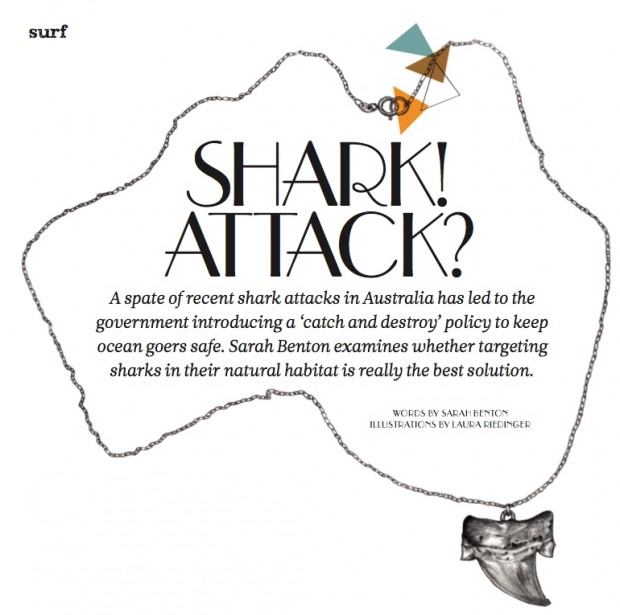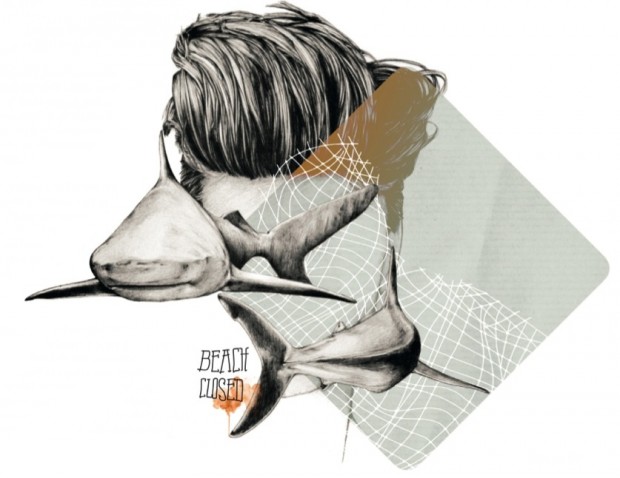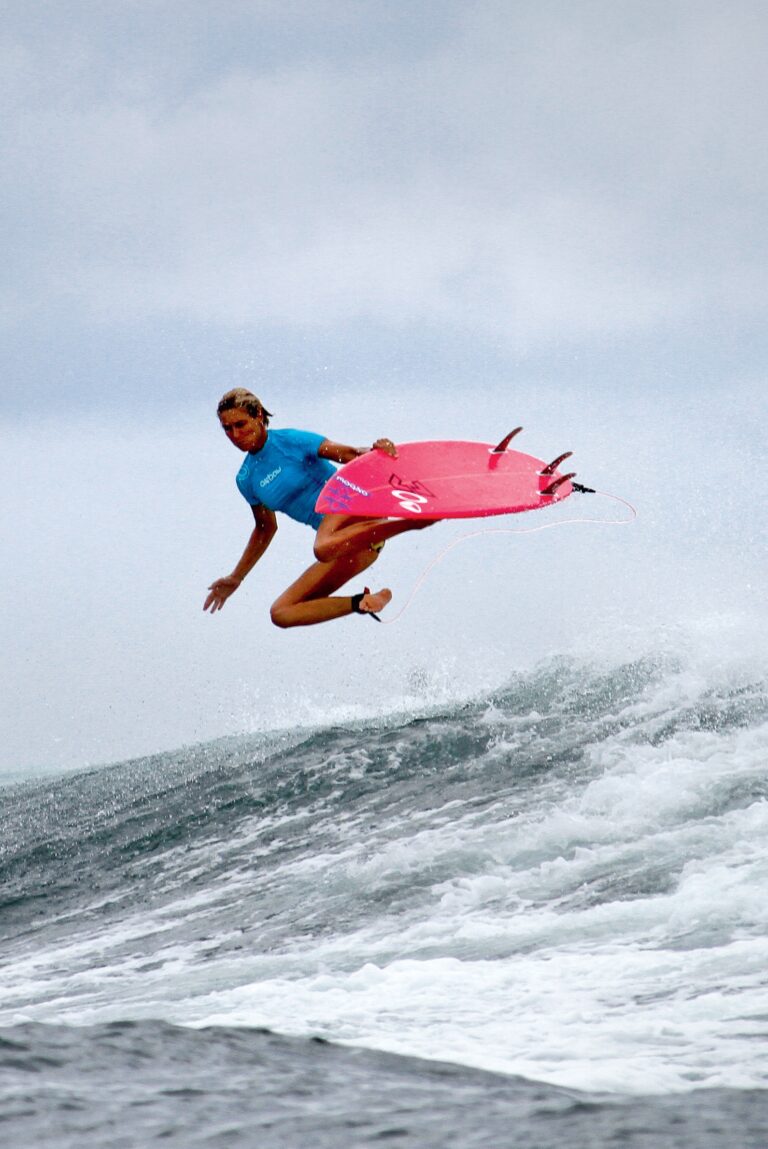
Words by Sarah Benton, illustrations by Laura Riedinger
Getting caught in the jaws of a shark is every surfer’s nightmare. This nightmare became a reality in July 2012 for Ben Linden, a cabinetmaker from Western Australia (WA). He was surfing a remote break north of Perth when he was torn in half by a great white shark. Just another statistic he was not; his death brought the number of fatalities in WA to five in 10 months, a number that caused alarm bells to ring in WA’s Fisheries Department.
Norman Moore, Fisheries Minister of WA, demanded a federal review of the protected status of great white sharks in Australian waters. As a result, the Australian government is allocating AUS$6.85 million to what it calls ‘shark mitigation’ strategies, which include AUS$2 million for the WA Department of Fisheries to track, catch and destroy sharks that pose a threat to humans. Under previous rules, sharks could only be killed after the fact, “but now proactive action will be taken if a large white shark presents imminent threat to people” said Moore. Although WA Premier Colin Barnett said the action was “not going to be a shark hunt,” he is prioritising the lives of beachgoers over sharks.
While the number of sharks in Australian waters is unknown, the number of attacks and fatalities is well documented. The Australian Shark Attack file, curated by John West at Taronga Zoo in Sydney, reveals there have been 540 recorded, unprovoked attacks in Australia between 1900 and 2009, 153 of which were fatal. What is interesting to note is the recent increase in attacks since a 1999 ban on shark culling. There were 6.5 incidents per year from 1990 to 2000 compared to 15 incidents per year from 2000-2009.
The rise in Australian shark attacks coincides with an increasing human population, more people visiting beaches, a rise in the popularity of water-based activities and people accessing previously isolated coastal areas. There is no evidence of increasing shark numbers that would influence the rise of attacks in Australian waters.
However, West doesn’t believe this has anything to do with the ban on hunting these giant ocean predators. “The rise in Australian shark attacks,” says West, “coincides with an increasing human population, more people visiting beaches, a rise in the popularity of water-based activities and people accessing previously isolated coastal areas. There is no evidence of increasing shark numbers that would influence the rise of attacks in Australian waters.” This is a view echoed by marine scientists throughout the world.
As surfers, we are particularly at risk. In Australia, 42% of attacks involve a surfer or body boarder. Sharks have trouble distinguishing between surfers and more traditional prey such as seals. Our wetsuits not only allow us to surf in colder waters – where large sharks such as the great white are found – they make us look, at least to a shark, more like seals. Additionally, as we seek out remoter breaks further from shore we are increasingly sharing waters with nature’s most successful predators.

Hawaiian surfer Mike Coots found out first hand just what it’s like to share waters with sharks. 15 years ago Mike, then 17, was surfing a remote break on Kauai’s west coast when his right foot was bitten off by a tiger shark. After weeks of surgery and rehab and with the addition of a carbon fibre prosthetic foot, Mike was back in the surf. “The most difficult part of getting attacked was not being in the ocean during the rehabilitation,” he says. “I was out of the water for about five weeks and the winter season was starting, all my friends were surfing and I wanted to get back in so bad. It just happened that the surf was good near the spot I got bitten so that’s where my first time back in was. I had zero fear of getting attacked again and still have no fear. The odds of it happening again are astronomical,” he jokes.
This perhaps isn’t the view you’d expect from someone who could have died in the jaws of another animal. What will perhaps come as more of a surprise is that Mike feels no animosity to sharks as a result. In fact, he is now a shark conservationist.
After the attack he was contacted by environmental group PEW about shark finning. Mike was so alarmed at the shocking statistics – 70 million sharks a year are slaughtered for their fins – he felt compelled to do something. “Growing up with the ocean meaning so much to myself, friends and family, it’s a responsibility I felt I inherited from the attack.”
Surfers are among the most at risk from shark attacks, but they are also in a unique position to understand the importance of maintaining a balance in the world’s oceans and reef systems.
Surfers are among the most at risk from shark attacks, but they are also in a unique position to understand the importance of maintaining a balance in the world’s oceans and reef systems. And sharks are a vital part of a healthy ecosystem says Alexa Wellbelove, Senior Programme Manager at Humane Society International (HSI).
“Sharks act as apex or top predators in their environment, maintaining the balance of all life beneath them,” says Wellbelove. “Healthy numbers of sharks are an indicator of the health of our marine environment, with research demonstrating that the massive depletion of sharks worldwide has had negative and cascading effects throughout our ocean ecosystems.”
Conservationists and scientists believe a cull is not the answer and more research is needed. “Removing the protection from sharks will not make our waters safer,” says Wellbelove, “but finding out as much as possible about sharks and any factors behind the attacks can provide us with further information to help prevent any future shark attacks”.
Removing the protection from sharks will not make our waters safer. But finding out as much as possible about sharks and any factors behind the attacks can provide us with further information to help prevent any future shark attacks.
So if scientists say a cull isn’t the solution, then what is?
In some parts of Australia the Ocean Tracking Network (OTN) uses satellite-linked receivers to alert authorities and scientists when a tagged shark comes within 500 metres of a particular beach. Cape Town in South Africa is about to trial the same system and Cape Cod in the US also runs a comprehensive tagging and tracking system. However, this is on a small scale but a large cost. The OTN has a global budget of US$168 million and currently only deals with a handful of sharks. In reality, this system is best described as a research project rather than a viable shark defence mechanism.
A simpler approach is being taken by Sam McCombie from Shark Alarm. Members of the public can submit sightings to Shark Alarm warning other site users about possible sharks in the vicinity of certain beaches. It’s aim, according to McCombie is to inform and make people aware of the hazards; “four out of six attacks in WA have had sightings of large great white sharks in the area days prior to the attack. Shark Alarm informs the public of where large potentially dangerous sharks have been seen so when people enter the water they know the true risk”.
But as the global population swells and more people venture into the water to surf and swim, unless some sort of action is taken shark attacks are going to become more commonplace. How can we make the waters safer without harming sharks?
“That’s the million dollar question,” says Mike, “and I have no answer. But I do know that sharks don’t like the taste of human flesh. If they did there would be an attack everyday around the world.” The chance of getting attacked by a shark is far lower than drowning and completely incomparable to the likelihood of getting run over, yet we don’t stop swimming and we are not about to ban cars, so why is the government of Western Australia implementing a track and destroy tactic? As Mike points out, “a hot sunny day on Waikiki Beach will bring tens of thousands of beach go-ers, and when was the last attack? Not in my lifetime.”




